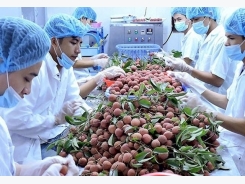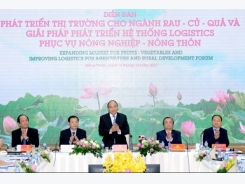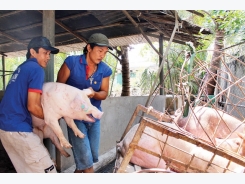Public-private partnership for transferring coffee exports from bagging to packaging

In order to solve the problem of sustainable growth and increase the value of Vietnamese coffee products, the Ministry of Agriculture and Rural Development called on enterprises to participate in public-private cooperation to support farmers in new farming techniques, instead of letting them plant and harvest under old, inefficient practices.
Most of coffee growers still cultivate and harvest using old practices, leading to low productivity and quality. Picture: ST.
Every stage is weak
At a recent conference on coffee development, Minister of Agriculture and Rural Development Nguyen Xuan Cuong affirmed that the potential of the coffee industry in Vietnam is still great. Specifically, the world market for coffee drinks reached $US 500 billion, while Vietnam only exported $US 3.4 billion. However, if only looking to export coffee beans, the value of revenue could be hard to increase. At the same time, the domestic demand is also a great opportunity for the coffee industry, so it is necessary to invest in a value added direction.
However, the head of agricultural industry also pointed out many inadequacies, and shortages of the coffee industry. It is in the link chain, the organization of the application of scientific and technical measures in the production process is not good; the area of old coffee cultivation and harvesting practices increased rapidly; the abuse of inputs, materials such as fertilizers, pesticides... especially the use of resources is not reasonable. These factors cause the high cost of producing Vietnamese coffee beans and the quality of the finished coffee beans is affected.
Mr. Doan Xuan Hoa, former Deputy Director of the Processing Department under the Ministry of Agriculture and Rural Development, pointed out that there are 150 domestic exporters and more than 3,000 coffee buyers in the country, including 13 FDI enterprises, but only one third of enterprises have factories processing coffee beans for export. Along with that, most enterprises are buying coffee beans through traders and purchasing agents for export, resulting in the low quality of coffee exports. At the same time, enterprises lack the link in negotiating the export price of coffee, leading to a price squeeze or export dumping. The management capacity of enterprises processing, trading and exporting coffee is not professional. Most Vietnamese coffee exporters have to sell their products through focal points and foreign businesses without direct access to world coffee roasters.
According to surveys and analysis of the data of the current coffee value chain in Vietnam, Mr. Hoa said that in the value chain from agricultural production to processing for export, the added value (VAT) of products is mainly in agricultural production, accounting for nearly 95% of the total production and processing accounted for approximately 4%, and collectors accounting for over 1%. In particular, although the value added of production is high, the profit earned by farmers for one hectare is only about VND 39.5 million. With a household size of 0.5 - 1 ha, the level of income from coffee is still low. In order to increase income, Mr. Hoa said that coffee growers need to link production, apply technical advances in breeding, in watering economically, and fertilizing to improve productivity and reduce costs.
According to Mr. Hoa, although for the collection process (agents) value added is low and the profit per ton is about 150,000 VND, due to the large volume the total value of profits for collectors is still very high. It is noteworthy that in this stage, they often do not comply with the quality requirements (buy bucket) and many negatives arise in the process of buying and selling (evading VAT, paying debts ...). Therefore, it is necessary to consolidate this stage in localities. On the other hand, if the link between processing enterprises and farmers is well made, through collective economic organizations, the intermediary costs will be reduced as well as the negatives arising from this stage.
In particular, in order to improve the value added, it is necessary to significantly improve the processing through deep processing, including ground roasted coffee, instant coffee and some other forms of processed coffee such as instant coffee tablet, coffee filter bag, decaffeinated coffee... President of the Vietnam Coffee and Cocoa Association Luong Van Tu also pointed out that, if it can participate in the distribution network of countries, the value of Vietnam’s coffee will be higher. In addition, exports of roasted and ground coffee may increase 2 times more than the value export of coffee beans.
Call for public-private partnerships
In order to convert coffee from “bagging to packaging”, experts say the PPP model is an effective and appropriate way of doing things in the current context. In fact, the ongoing PPP projects have gained significant results in raising farmer incomes as well as improving the quality of coffee products.
Typically, the Nescafe Plan has been implemented by the Nestlé Vietnam Company in the Central Highlands provinces since 2011. The goal of the project is to develop a sustainable coffee cultivation that not only improves productivity but also contributes to income generation for farmers, ensuring a sustainable farming environment with a 20-20-20 vision by 2020 (a 20% increase in productivity - an increase of 20% in income - a 20% reduction in greenhouse gas emissions). After 7 years of implementation, the project has distributed over 20 million ha of high-yield, disease-resistant seedlings to support farmers to replant over 20,000 hectares of coffee trees. At the same time, it also implemented training on sustainable farming techniques for more than 200,000 farmers. Thereby, 21,000 farmers receive 4C international coffee certificate. With the Nescafe Plan, farmers' incomes increases by 30%, while reducing 40% of irrigation water and 20% of chemical fertilizers and pesticides. In the coming time, the project will continue to be expanded to accelerate re-cultivation of coffee trees as well as farmer training.
However, in general, Nestlé Vietnam's project only accounts for less than 17% of the coffee area that needed re-cultivation and these models such as Nescafé Plan are small. Dr. Nguyen Do Anh Tuan, Director of the Institute for Strategic Policy, Ministry of Agriculture and Rural Development, also cites data from a report on the extent of linking farmer households and enterprises in coffee production and consumption in provinces in the Central Highlands showed that the current models only account for about 20% of the coffee growers, 32% of the area, and 42% of the country's coffee production.
Therefore, in order to sustain development of the coffee industry, it needs more co-operative projects. As a result, the leader of the Ministry of Agriculture and Rural Development expects that in the coming time, there will be more companies with public-private partnerships to support farmers in new farming techniques to create new products. The products are certified to meet the requirements of importers, while enhancing the value of Vietnamese coffee products.
Có thể bạn quan tâm
Phần mềm

Phối trộn thức ăn chăn nuôi

Pha dung dịch thủy canh

Định mức cho tôm ăn

Phối trộn phân bón NPK

Xác định tỷ lệ tôm sống

Chuyển đổi đơn vị phân bón

Xác định công suất sục khí

Chuyển đổi đơn vị tôm

Tính diện tích nhà kính

Tính thể tích ao hồ



 Japanese garlic may overtake Ly Son garlic fields…
Japanese garlic may overtake Ly Son garlic fields…  Vietnamese pig farmers losing to foreign rivals on…
Vietnamese pig farmers losing to foreign rivals on…